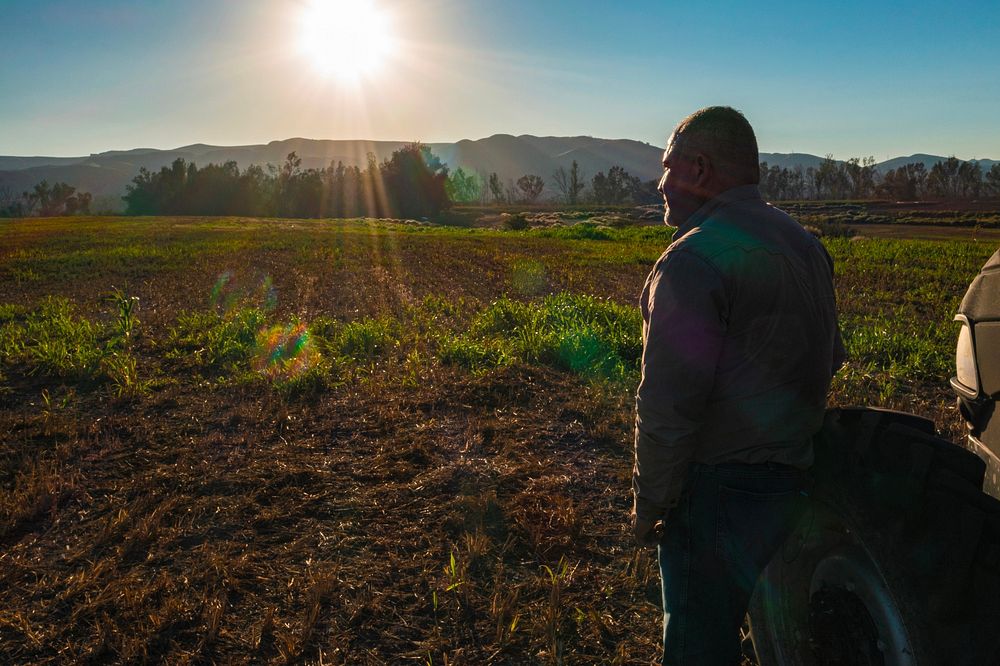https://www.usa.gov/copyrighted-government-workshttps://www.rawpixel.com/image/9654731

Disabled Army veteran, new farmer and owner-operator of Prado Recreation Inc. Ruben Llamas, leases more than 585 acres from the U.S. Army Corps of Engineers, where his family and employees farm more than half of that and maintain the rest as a dog training facility, where the U.S. Department of Agriculture USDA Natural Resources and Conservation Service NRCS has helped him improve the health of the land and the profitability of the farm with the replacement of six new tractors, a loader, and technical assistance in the basin of the Prado Dam area, in Chino, CA, on Oct. 21, 2022. The facility is 36 miles east of Los Angeles, 11 miles south of Ontario, in what is known as the Inland Empire.
Sergeant Llamas served in the U.S. Army for 13 years as a Combat Engineer and a Scout. He was assigned to the U.S. Army 578th Brigade Engineer Battalion and the California Army National Guard 18th Calvery Regiment. He and his wife have six children; two are serving in the U.S. Army, one in the U.S. Coast Guard, and one is considering enlisting herself.
The basin’s range of environments and topography supports a wide variety of training grounds for sporting dogs, rescue tracking dogs, obedience training, and the ability to provide kennel facilities and the maintenance of waterfowl habitats and outdoor recreation areas. The farm fields of grasses and natural meadows provide nesting. Their seeds feed migrating birds near a hunting club and the broader wetlands. Hunting dog trainers use the forests, fields, meadows, ponds, and islands to train dogs to find game birds for hunters.
The U.S. Army Corps of Engineers controls the approximately 4,500-acres Prado Dam area. Their lease is for more than 500 acres near the dam and Highway 71.
They purchased the business 16 years ago. The land ranges from farm fields to wetlands and woodlands. Three counties with about 15 million people surround the area.
The farm produces alfalfa, corn, and other forage crops for silage sold to local dairies. Winter crops are wheat, winter wheat, oats, and ryegrass. In the summer, they grow sorghum, corn, milo, and various types of grass. All the fields at different stages of growth are used for hunting dog training, as it provides cover for waterfowl and challenges to rescue dogs in training.
Ruben Llamas is a new farmer who wants to be as profitable as possible and develop his best practices. To help him, Llamas discovered the USDA Natural Resources and Conservation Service online at usda.gov. He called the nearest NRCS Field Office in Redlands, CA. District Conservationist Tomas Aguilar-Campos answered the phone and immediately helped him with the information and ways to begin networking. To better understand Llamas’s farm and conservation needs Campos went to see him at the farm in the Prado Dam basin. Llamas was hesitant to provide information to the government and work with them but decided to try it. He now compares his experience with USDA to be similar to a bank customer and their banker.
The business came with 40-year-old tractors that were unreliable, produced higher emissions, and were expensive to maintain. Thanks to the USDA Environmental Quality Incentives Program EQIP and the USDA assistance with the application process, he qualified for the replacement of six tractors and a loader. Now, there is no problem operating any of them at any time. The robust and reliable equipment accomplishes twice the work in half the time and does it with 30 percent less fuel, says Llamas.
NRCS EQIP provides technical and financial assistance to producers to address natural resource concerns and deliver environmental benefits such as improved water and air quality, conserved ground and surface water, increased soil health and reduced soil erosion and sedimentation, improved or created wildlife habitat, and mitigation against drought and increasing weather volatility.
Equally as old were the irrigation systems. So, next, the pump and mainline, and distribution pipe needed improvement. To test the system Tomas and another specialist came to test the irrigation system. He recommended larger lines and a smaller pump for lower energy costs and better efficiency.
“The field representative, they’re always there, ready to help, says Llamas. With whatever question I have, they will help me.”
During the winter, the lower wetlands and farm fields become flooded with rainwater. The water attracts local and migratory birds. They come to eat, rest and leave the soil richer from their time there.
In the lowest field, seasonal flooding made it difficult to farm. Aguilar-Campos responded by asking a USDA soil specialist to examine the land. Compost was the recommendation, resulting in consistent farming and increased yields.
Because of the varying soils, Aguilar-Campos had a soil analysis performed. It showed that composting would help. The compost revitalized the soil to the point that certain crops needed 30 percent less water, and corn required 18 percent less water. Another result is that weed suppression has improved, so chemical use is down from an already sparing use.
Ruben Llamas says, “It’s been a really great relationship. I mean, I got seven pieces of equipment, so it’s been really, really good.”
For more information about EQIP, go to nrcs.usda.gov/programs-initiatives/eqip-environmental-quality-incentives
For more information about NRCS Conservation Practice 533 Pumping Plant please see efotg.sc.egov.usda.gov/api/CPSFile/14941/533_NC_CPS_Pumping_Plant_2011
For more information about NRCS Conservation Practice 430, Irrigation Pipe, please see nrcs.usda.gov/sites/default/files/2022-09/Irrigation_Pipeline_430_Overview_9_2020.pdf
For more information about NRCS Conservation Practice 443 Irrigation System please see nrcs.usda.gov/sites/default/files/2022-09/Irrigation_System_Surface_And_Subsurface_443_Overview.pdf
USDA Media by Lance Cheung.
Original public domain image from Flickr
Public DomainFree CCO U.S. Government image for Personal and Business use